Abstract
Cytotoxic T lymphocytes (CTL) with the CD4+ phenotype that recognize major histocompatibility complex (MHC) class II antigens are detectable very frequently in cultures of human alloreactive or virus-specific T cells. The significance of these CD4+ CTL for an immune reaction in vivo is not clear. Since Epstein-Barr virus (EBV) transformed B cells express HLA-class I and class II antigens equally well both CD8+ and CD4+ CTL should be stimulated during an acute EBV infection. We analysed the MHC specificity and the phenotype of EBV-specific CTL from patients with infectious mononucleosis (IM). When tested directly without any previous culture, T cells from patients in the acute phase of IM showed specific MHC-restricted cytotoxicity against the autologous B cell line. Addition of a HLA class I specific monoclonal antibody (MoAb) but not of a HLA class II specific MoAb resulted in a complete blocking of the lytic activity. Cell sorting revealed that the entire cytotoxic activity was present in the CD8+ fraction whereas no specific CTL were detectable in the CD4+ fraction. The absence of cytotoxicity in CD4+ cells was not due to a lack of activation of these cells since both CD8+ and CD4+ cells were activated in situ, showing spontaneous growth in interleukin-2 (IL-2) and expressing the activation marker TP103. Frequency estimation revealed that 1/300-1/600 CD8+ but only 1/2000-1/4000 CD4+ T cells gave rise to a specific CTL colony after 10 days. If CD4+ colonies were tested repeatedly for cytotoxicity we found that CD4+ CTL acquired their cytotoxicity during in vitro culture. In addition, we isolated EBV-specific CD4+ T cell clones able to lyse their stimulator cells in the presence but not in the absence of lectin, even after a long period of culture. Taken together our results show that cytotoxicity mediated by CD4+ T cells does not play a role in an anti-viral immune response.
Full text
PDF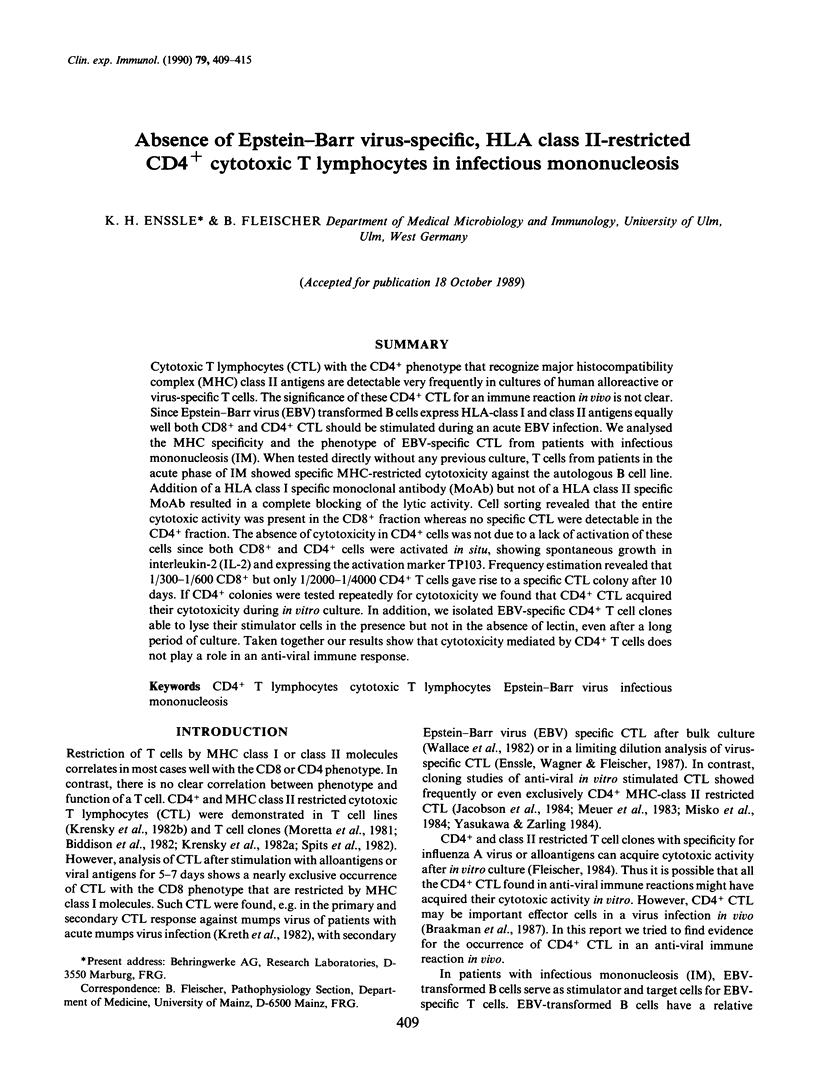
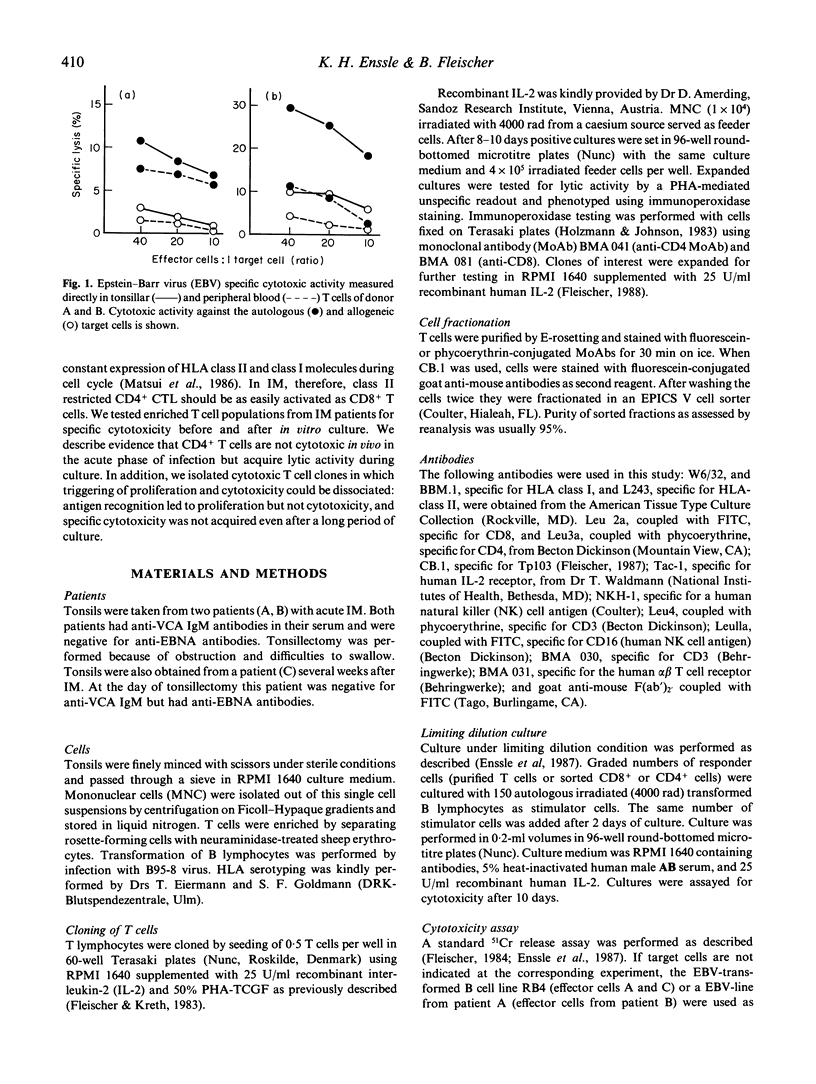
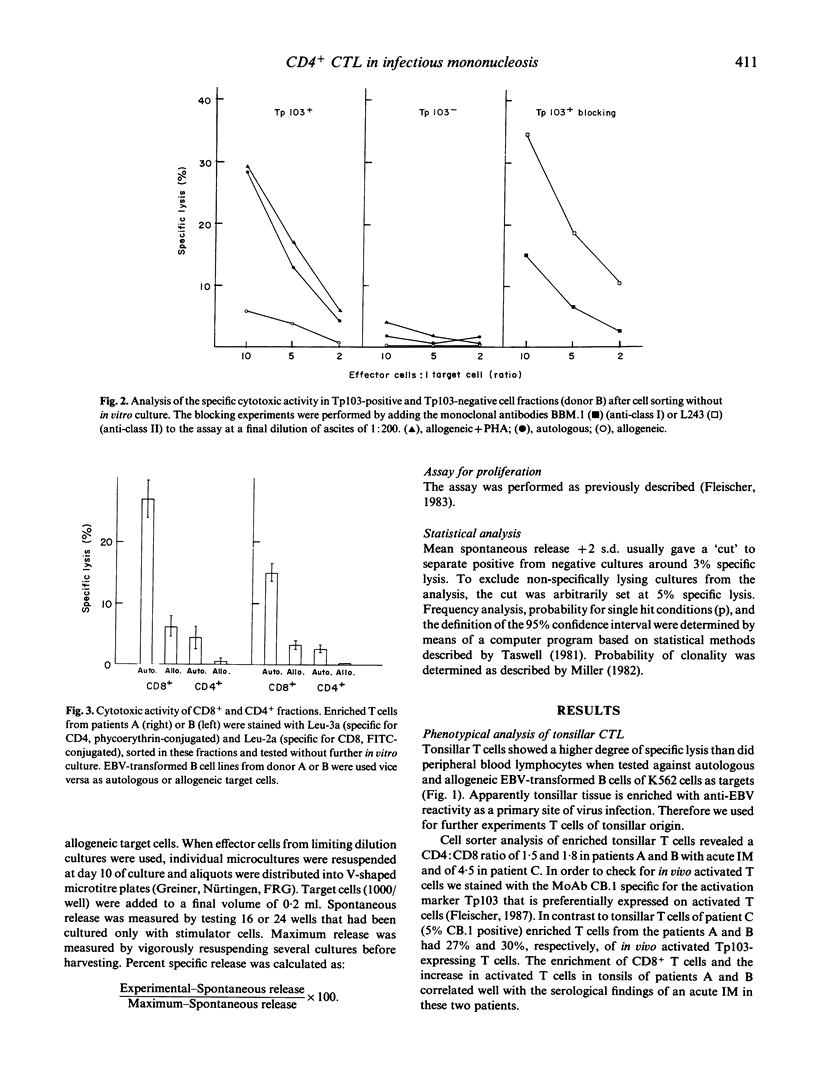
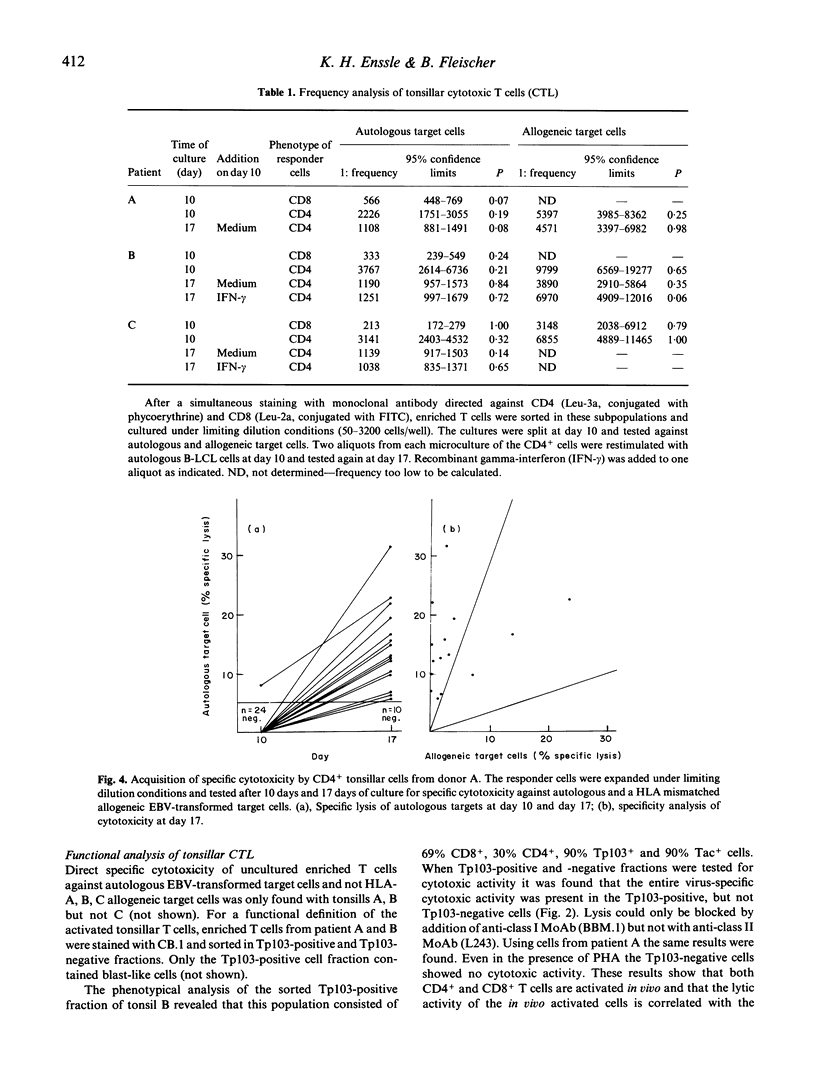

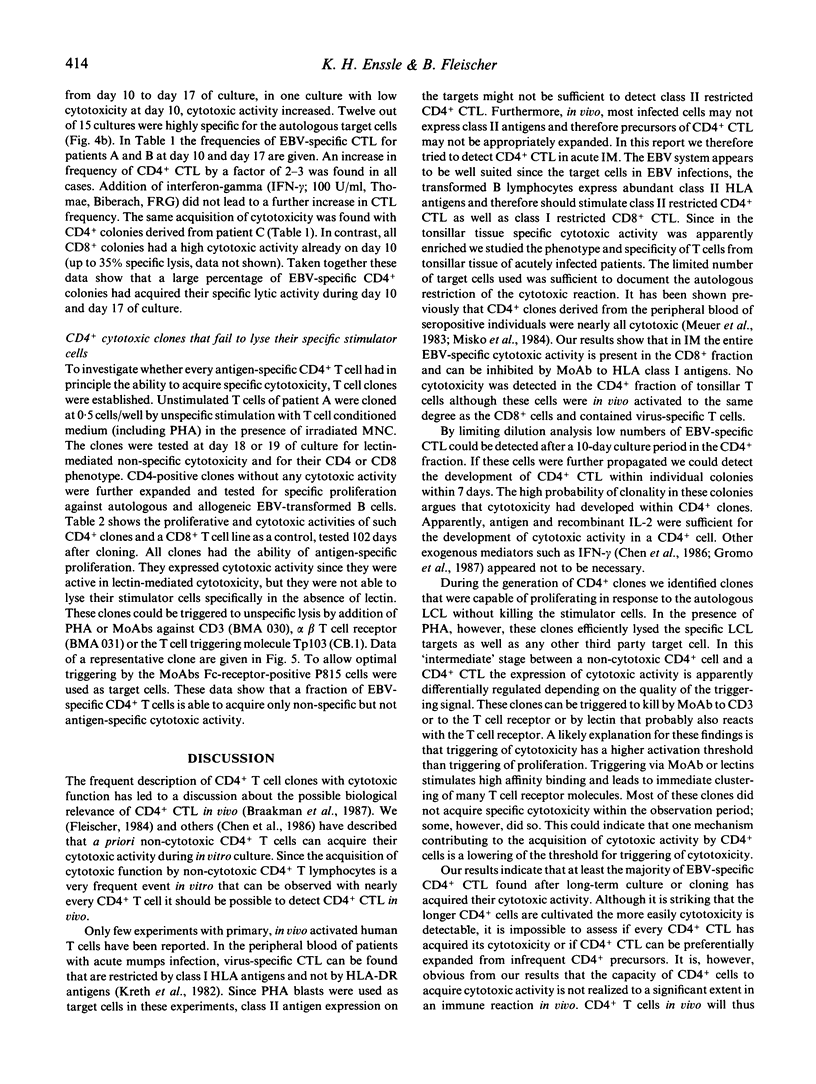
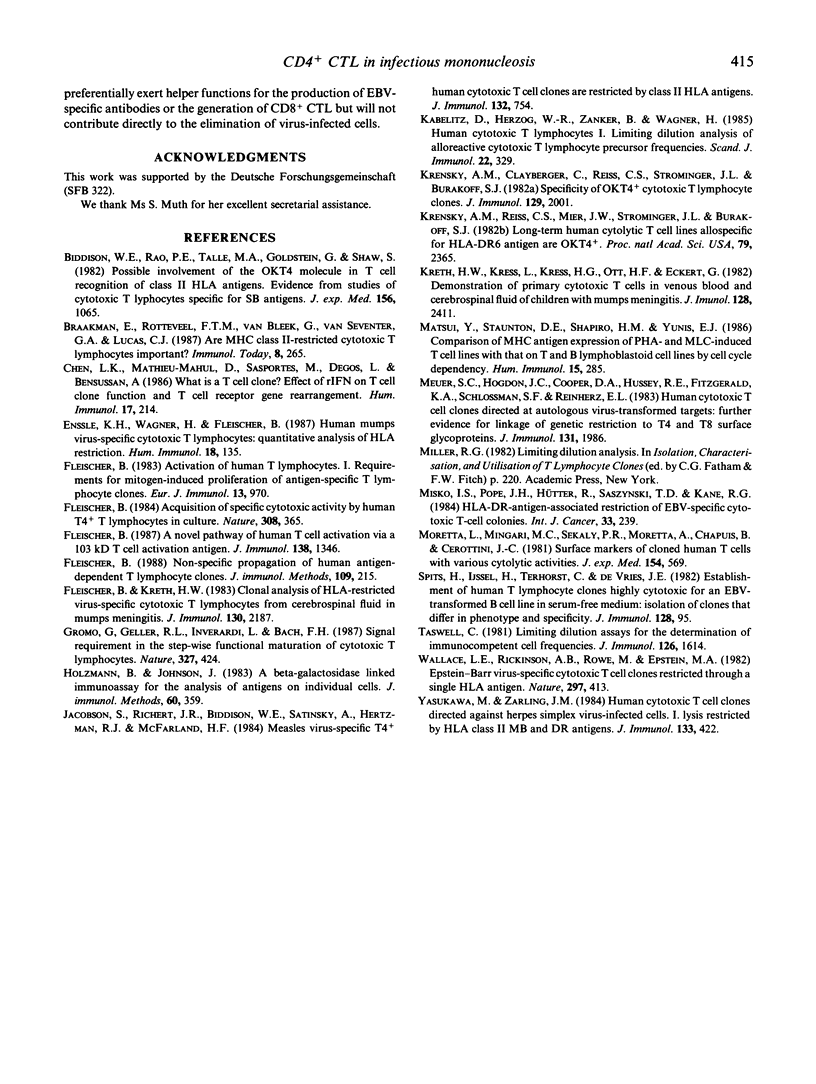
Selected References
These references are in PubMed. This may not be the complete list of references from this article.
- Biddison W. E., Rao P. E., Talle M. A., Goldstein G., Shaw S. Possible involvement of the OKT4 molecule in T cell recognition of class II HLA antigens. Evidence from studies of cytotoxic T lymphocytes specific for SB antigens. J Exp Med. 1982 Oct 1;156(4):1065–1076. doi: 10.1084/jem.156.4.1065. [DOI] [PMC free article] [PubMed] [Google Scholar]
- Chen L. K., Mathieu-Mahul D., Sasportes M., Degos L., Bensussan A. What is a T-cell clone? Effect of rIFN on T-cell clone function and T-cell receptor gene rearrangement. Hum Immunol. 1986 Nov;17(3):214–223. doi: 10.1016/0198-8859(86)90273-9. [DOI] [PubMed] [Google Scholar]
- Enssle K. H., Wagner H., Fleischer B. Human mumps virus-specific cytotoxic T lymphocytes: quantitative analysis of HLA restriction. Hum Immunol. 1987 Feb;18(2):135–149. doi: 10.1016/0198-8859(87)90011-5. [DOI] [PubMed] [Google Scholar]
- Fleischer B. A novel pathway of human T cell activation via a 103 kD T cell activation antigen. J Immunol. 1987 Mar 1;138(5):1346–1350. [PubMed] [Google Scholar]
- Fleischer B. Acquisition of specific cytotoxic activity by human T4+ T lymphocytes in culture. Nature. 1984 Mar 22;308(5957):365–367. doi: 10.1038/308365a0. [DOI] [PubMed] [Google Scholar]
- Fleischer B. Activation of human T lymphocytes I. Requirements for mitogen-induced proliferation of antigen-specific T lymphocyte clones. Eur J Immunol. 1983 Dec;13(12):970–976. doi: 10.1002/eji.1830131204. [DOI] [PubMed] [Google Scholar]
- Fleischer B., Kreth H. W. Clonal analysis of HLA-restricted virus-specific cytotoxic T lymphocytes from cerebrospinal fluid in mumps meningitis. J Immunol. 1983 May;130(5):2187–2190. [PubMed] [Google Scholar]
- Fleischer B. Non-specific propagation of human antigen-dependent T lymphocyte clones. J Immunol Methods. 1988 May 9;109(2):215–219. doi: 10.1016/0022-1759(88)90245-1. [DOI] [PubMed] [Google Scholar]
- Gromo G., Geller R. L., Inverardi L., Bach F. H. Signal requirements in the step-wise functional maturation of cytotoxic T lymphocytes. Nature. 1987 Jun 4;327(6121):424–426. doi: 10.1038/327424a0. [DOI] [PubMed] [Google Scholar]
- Holzmann B., Johnson J. P. A beta-galactosidase linked immunoassay for the analysis of antigens on individual cells. J Immunol Methods. 1983 Jun 10;60(3):359–367. doi: 10.1016/0022-1759(83)90293-4. [DOI] [PubMed] [Google Scholar]
- Kabelitz D., Herzog W. R., Zanker B., Wagner H. Human cytotoxic T lymphocytes. I. Limiting-dilution analysis of alloreactive cytotoxic T-lymphocyte precursor frequencies. Scand J Immunol. 1985 Sep;22(3):329–335. doi: 10.1111/j.1365-3083.1985.tb01888.x. [DOI] [PubMed] [Google Scholar]
- Krensky A. M., Clayberger C., Reiss C. S., Strominger J. L., Burakoff S. J. Specificity of OKT4+ cytotoxic T lymphocyte clones. J Immunol. 1982 Nov;129(5):2001–2003. [PubMed] [Google Scholar]
- Kreth H. W., Kress L., Kress H. G., Ott H. F., Eckert G. Demonstration of primary cytotoxic T cells in venous blood and cerebrospinal fluid of children with mumps meningitis. J Immunol. 1982 Jun;128(6):2411–2415. [PubMed] [Google Scholar]
- Matsui Y., Staunton D. E., Shapiro H. M., Yunis E. J. Comparison of MHC antigen expression on PHA- and MLC-induced T cell lines with that on T and B lymphoblastoid cell lines by cell cycle dependency. Hum Immunol. 1986 Mar;15(3):285–301. doi: 10.1016/0198-8859(86)90004-2. [DOI] [PubMed] [Google Scholar]
- Misko I. S., Pope J. H., Hütter R., Soszynski T. D., Kane R. G. HLA-DR-antigen-associated restriction of EBV-specific cytotoxic T-cell colonies. Int J Cancer. 1984 Feb 15;33(2):239–243. doi: 10.1002/ijc.2910330212. [DOI] [PubMed] [Google Scholar]
- Moretta L., Mingari M. C., Sekaly P. R., Moretta A., Chapuis B., Cerottini J. C. Surface markers of cloned human T cells with various cytolytic activities. J Exp Med. 1981 Aug 1;154(2):569–574. doi: 10.1084/jem.154.2.569. [DOI] [PMC free article] [PubMed] [Google Scholar]
- Spits H., Ijssel H., Terhorst C., de Vries J. E. Establishment of human T lymphocyte clones highly cytotoxic for an EBV-transformed B cell line in serum-free medium: isolation of clones that differ in phenotype and specificity. J Immunol. 1982 Jan;128(1):95–99. [PubMed] [Google Scholar]
- Taswell C. Limiting dilution assays for the determination of immunocompetent cell frequencies. I. Data analysis. J Immunol. 1981 Apr;126(4):1614–1619. [PubMed] [Google Scholar]
- Wallace L. E., Rickinson A. B., Rowe M., Epstein M. A. Epstein-Barr virus-specific cytotoxic T-cell clones restricted through a single HLA antigen. Nature. 1982 Jun 3;297(5865):413–415. doi: 10.1038/297413a0. [DOI] [PubMed] [Google Scholar]
- Yasukawa M., Zarling J. M. Human cytotoxic T cell clones directed against herpes simplex virus-infected cells. I. Lysis restricted by HLA class II MB and DR antigens. J Immunol. 1984 Jul;133(1):422–427. [PubMed] [Google Scholar]


